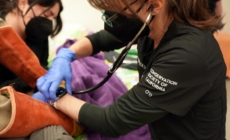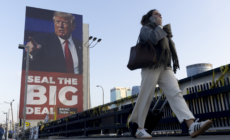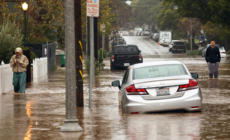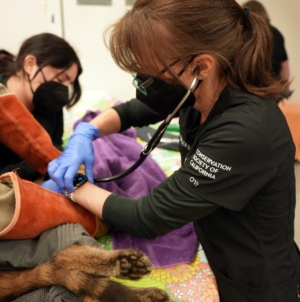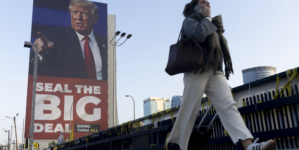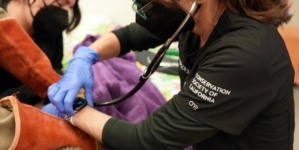-
Children’s Hospital L.A. stops initiating hormone therapy for trans youth - 9 mins ago
-
Trump and Netanyahu to Discuss Ceasefire, Plans for Gaza Strip - 25 mins ago
-
Want Eggs With Your Breakfast? Pay a Surcharge, Waffle House Says. - 29 mins ago
-
Newsom heads to D.C. to meet with Trump officials - 50 mins ago
-
Travis Kelce Reveals His Favorite Taylor Swift Album - 60 mins ago
-
Patriots Owner’s Son Challenges Michelle Wu for Mayor of Boston - about 1 hour ago
-
Newsom lifts caps for new home rents in wealthy L.A. neighborhoods - 2 hours ago
-
Celebs Who Called Off Their Divorces and Got Back Together - 2 hours ago
-
How Canada and Mexico’s Leaders Took Different Routes to a Tariff Deal With Trump - 2 hours ago
-
Atmospheric River Pummeling California Seen From Space - 2 hours ago
Malibu balks at fire debris proposal as EPA struggles to find sites

A request by the Environmental Protection Agency to open a processing site for fire debris near Malibu City Hall prompted swift backlash from residents and local officials alarmed by the prospect of hazardous waste being stored in a busy part of town near multiple schools.
In a special meeting of the Malibu City Council on Monday, federal officials said they hoped to use a concrete-covered lot near the Civic Center as a temporary staging area for potentially hazardous household items — such as paint, bleach, asbestos, propane tanks and lithium-ion batteries — removed from the Palisades fire burn zone.
But, as with opposition to other EPA staging sites, the discussion was sometimes heated, and residents’ frustration was clear. Jeremy Fink, who said he has a child who attends school near the proposed site, said he resented comparisons of fire debris to household cleaning items in need of disposal.
“I do resent comparing this to, like, cleaning out some old, like, Drano,” he said. “This is not f— Drano.”
The lot at the corner of Webb Way and Civic Center Way is half a mile from two elementary school campuses: the public Webster Elementary School and private Our Lady of Malibu School, a Catholic campus. It also is less than a quarter of a mile from the Santa Monica College Malibu Campus and one mile from Pepperdine University.
“As mayor of this city, I can’t encourage you to put this site across the street from us, so close to all these kids, homes and so forth,” Mayor Doug Stewart told the federal officials.
Members of the City Council said they were caught off guard by the federal agencies’ sudden interest in the lot. Consideration of the space as a debris collection site was not on the agenda for the special meeting — so they did not vote on it.
But both elected officials and residents expressed dismay at the location.
The proposed staging site is the latest to face local opposition as the EPA tries to expedite hazardous waste cleanup after the Palisades and Eaton fires. The process was initially projected to last three months, but President Trump requested it be done in 30 days.
Debris collection sites already in use at Lario Park in Irwindale and at the intersection of Topanga Canyon Boulevard and Pacific Coast Highway just east of Malibu city limits have faced heated protests.
On Monday, federal officials said they wanted to use the lot near Malibu City Hall, called the Bell lot, as a staging area — a temporary storage site where hazardous materials are sorted and prepared for final disposal off-site.
“We have a sense of urgency,” said Michael Montgomery, director of the EPA’s Region 9 Superfund division, at the meeting.
He said he hoped Malibu officials would approve use of the site within 24 to 48 hours.
Tara Fitzgerald, an EPA incident commander, told those at the meeting that waste does not touch the ground at the staging areas but is stored in thick, sealed plastic drums and bags inside a tent with protective flooring.
“We have struggled to find locations where local agencies are supportive of our work, although we are expected to do it,” Fitzgerald said.
She said the sites take in large lithium-ion batteries, like those in electric vehicles, which cannot be placed in landfills.
Batteries damaged by fire “continue to pose a serious safety risk as heat-impacted lithium batteries can spontaneously explode, ignite or release toxic gases,” she said.
At the staging areas, she said, “these batteries are de-energized, disassembled, recycled and disposed of safely without risk to the public.”
FEMA Regional Administrator Robert Fenton said federal agencies need more than 20 acres of staging areas for each of the fire zones. The few that exist are operating at near capacity, he said, and “significantly more” space is needed to deal with the waste that currently sits in open air in the burn sites.
“The risk of it being in an open environment is far greater than any risk of using a staging area to temporarily put it at,” Fenton said at Monday’s meeting.
An inability to find sites, he said, will slow the cleanup process.
The federal officials said air monitoring and soil testing are among the safety measures conducted at the sites to ensure they do not pose a threat to public health.
When members of the City Council expressed concern about the proposed site’s proximity to schools, Fitzgerald said there is “no risk outside of our perimeter.”
Marni Kamins, who said her child attends class near the site, told the federal officials that although she understood the sense of urgency, she was outraged by the location so close to schools.
“I hate to tell everybody this, but it’s going to be a long process,” she said. “You guys aren’t going to get your homes rebuilt fast. And if we take an extra week to find a different staging site, it’s going to save all the people that live right here and all the businesses.”
She said of Malibu, an environmentally conscious city that banned restaurants from giving out plastic straws and utensils: “We voted for wooden forks that give you splinters in your lips. We have communist straws. … And you guys are gonna say this is fine to put hazardous waste [here]?”
Jo Drummond, who lives in Malibu’s Big Rock neighborhood, noted that the people opposed to the site at the meeting did not lose their homes. She did lose hers, and she was grateful the EPA was there.
“We need them to clean up our lots,” she said. “Every day, I walk through my neighborhood, I need to wear a P100 mask.”
The debris, she said, is “blowing all over Malibu. It’s going into our oceans. We’re poisoning our children as we stand here. So we need to clean it up fast.”
She added: “I do not like Trump. I am not a Trump person. But he is getting things done. So please act like him and get it done. Please clean our lots.”
Mayor Stewart said he agreed that it was “worse to do nothing” about the waste. But, he said, a bigger, better site would be the parking lot at Will Rogers State Beach, which is in the burn zone and not surrounded by occupied homes, businesses and schools.
Fenton said use of the Will Rogers site had already been denied.
City Councilman Bruce Silverstein said he was frustrated that the Will Rogers site — outside of Malibu city limits — was not being used. He said it felt like his city was being overshadowed in discussions about the Palisades fire.
“I watched the Grammys last night. It’s all about ‘L.A. strong,’” he said. “I see press conferences. It’s all about the city of Los Angeles and the Palisades. The name Malibu hardly ever gets mentioned.”
He added: “The good reason for that is we really are a small portion of what has burned. The bad reason is there’s a giant ape; the 800-pound gorilla is the city of Los Angeles, and they seem to be driving the boat.”
Silverstein said he was convinced that “political forces in the city of Los Angeles” were trying to keep hazardous-waste processing sites out of L.A. He said they should be there “because that’s where the vast majority of the carnage occurred. That’s where the fire started.”
Source link


